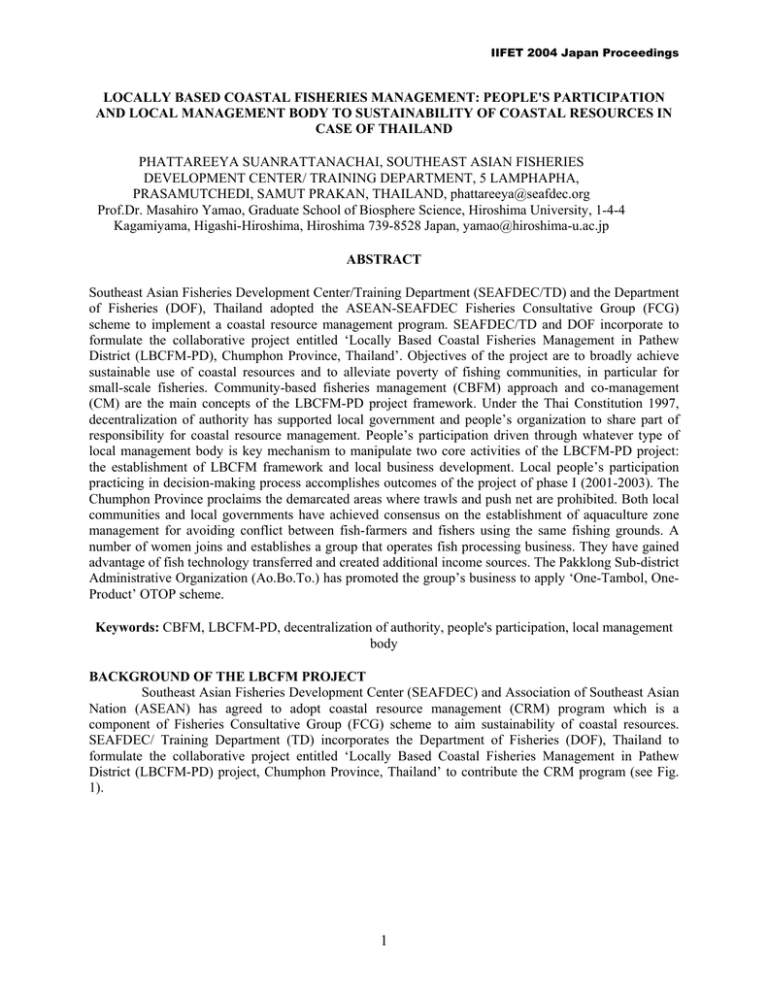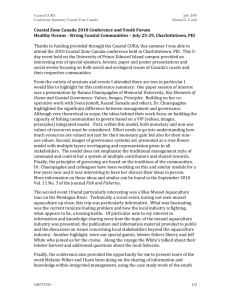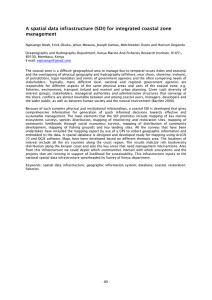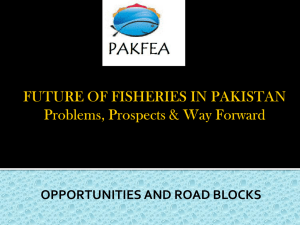LOCALLY BASED COASTAL FISHERIES MANAGEMENT: PEOPLE'S PARTICIPATION
advertisement

IIFET 2004 Japan Proceedings LOCALLY BASED COASTAL FISHERIES MANAGEMENT: PEOPLE'S PARTICIPATION AND LOCAL MANAGEMENT BODY TO SUSTAINABILITY OF COASTAL RESOURCES IN CASE OF THAILAND PHATTAREEYA SUANRATTANACHAI, SOUTHEAST ASIAN FISHERIES DEVELOPMENT CENTER/ TRAINING DEPARTMENT, 5 LAMPHAPHA, PRASAMUTCHEDI, SAMUT PRAKAN, THAILAND, phattareeya@seafdec.org Prof.Dr. Masahiro Yamao, Graduate School of Biosphere Science, Hiroshima University, 1-4-4 Kagamiyama, Higashi-Hiroshima, Hiroshima 739-8528 Japan, yamao@hiroshima-u.ac.jp ABSTRACT Southeast Asian Fisheries Development Center/Training Department (SEAFDEC/TD) and the Department of Fisheries (DOF), Thailand adopted the ASEAN-SEAFDEC Fisheries Consultative Group (FCG) scheme to implement a coastal resource management program. SEAFDEC/TD and DOF incorporate to formulate the collaborative project entitled ‘Locally Based Coastal Fisheries Management in Pathew District (LBCFM-PD), Chumphon Province, Thailand’. Objectives of the project are to broadly achieve sustainable use of coastal resources and to alleviate poverty of fishing communities, in particular for small-scale fisheries. Community-based fisheries management (CBFM) approach and co-management (CM) are the main concepts of the LBCFM-PD project framework. Under the Thai Constitution 1997, decentralization of authority has supported local government and people’s organization to share part of responsibility for coastal resource management. People’s participation driven through whatever type of local management body is key mechanism to manipulate two core activities of the LBCFM-PD project: the establishment of LBCFM framework and local business development. Local people’s participation practicing in decision-making process accomplishes outcomes of the project of phase I (2001-2003). The Chumphon Province proclaims the demarcated areas where trawls and push net are prohibited. Both local communities and local governments have achieved consensus on the establishment of aquaculture zone management for avoiding conflict between fish-farmers and fishers using the same fishing grounds. A number of women joins and establishes a group that operates fish processing business. They have gained advantage of fish technology transferred and created additional income sources. The Pakklong Sub-district Administrative Organization (Ao.Bo.To.) has promoted the group’s business to apply ‘One-Tambol, OneProduct’ OTOP scheme. Keywords: CBFM, LBCFM-PD, decentralization of authority, people's participation, local management body BACKGROUND OF THE LBCFM PROJECT Southeast Asian Fisheries Development Center (SEAFDEC) and Association of Southeast Asian Nation (ASEAN) has agreed to adopt coastal resource management (CRM) program which is a component of Fisheries Consultative Group (FCG) scheme to aim sustainability of coastal resources. SEAFDEC/ Training Department (TD) incorporates the Department of Fisheries (DOF), Thailand to formulate the collaborative project entitled ‘Locally Based Coastal Fisheries Management in Pathew District (LBCFM-PD) project, Chumphon Province, Thailand’ to contribute the CRM program (see Fig. 1). 1 IIFET 2004 Japan Proceedings Fig. 1 Site map of the LBCFM-PD project at Pakklong Sub-district, Pathew District, Chumphon Province, Thailand The LBCFM-PD project is financially supported by the Japanese government arranged the Japanese Trust Funds to SEAFDEC/TD, meanwhile, the DOF and the Thai Royal project provide budgets are as the operating funds to implement the project. Objectives of the project are fundamentally composed of 1) the establishment of sustainable use of coastal resource management at local level; 2) the rehabilitation of coastal resources; 3) the alleviation of poverty in coastal fishing communities [1]. THE LBCFM-PD PROJECT TIMEFRAME The project timeframe composes of two phases (see Fig.2). The phase I of the project implemented in the first two years (year 2001-2003) and phase II is the next three year (year 2004-2006) of the project. The phase I of the project placed an emphasis on stimulating local people participate in the project and also provides information related to advance technology in fisheries management and community development through training course arrangement to them. The DOF would take leading party to implement the project at local level; meanwhile, SEAFDEC/TD begins to transfer gained experiences through the project to other ASEAN member countries in the beginnings of the phase II of the project. 2 IIFET 2004 Japan Proceedings Year 2001 2003 Preparation for a Collaborative Project 2004 Mid-term Evaluation Phase I Thailand SEAFDEC/TD 2002 Seminar on LBCFM-PD 2005 Phase II Technology Transfer Member Countries 2006 Final Evaluation Seminar on LBCFM-PD Preparation for projects in member countries http://td.seafdec.org/locally-based/ Fig. 2 LBCFM-PD project timeframe CONCEPTUAL FRAMEWORK AND WORKABLE COMPONENTS Core approaches to locally based coastal management Conceptual framework of the LBCFM-PD project broadly bases on two core concepts are community-based fisheries management (CBFM) and co-management (CM) approaches. CBFM approach is mechanism to enhance people’s awareness building, establish and organize fishers’ group to make practical progress in the sustainability of coastal resources. CM approach is given definition that government agency shares responsibility and/or function with certain authority to manage coastal resources with local stakeholders and/ or resource users enroll as counterparts [2]. People participatory approach is fundamentally driven the two core concepts to contribute decentralization and deofficiallization of authorities from central government to local management body and/or entity. The new Thai Constitution, 1997 has officially promulgated to strongly encourage local people’s participation driven local management body in CRM implementation. Comprehensive structure of decentralization to strengthen coastal resource management The LBCFM-PD project is a pilot project to illustrate a lesson of local management body functioning in decentralization of authority. Central government devolves authority moved toward to localization, which consisted of Province, District and Sub-district (see Fig. 3). Recently, Sub-district Administrative Organization (Ao.Bo.To.) is as official local management body (LMB), which legally established in 1994, takes function in devolution of authority. 3 IIFET 2004 Japan Proceedings Present Near future DOF (Center) Consolidation & Abolition Provincial office of Fisheries Provincial office of Fisheries Devolution Local level Ao.Bo.Tos District office of Fisheries Collection of fee, registration, monitoring,etc. Fig. 3 Devolution of District function Members of Ao.Bo.To. are elected from the people in the village and take responsibilities for community development and the people’s welfare and resource-based management. Ao.Bo.To. would have following three elementary functions [1]: a) Administrative unit of fisheries management Ao.Bo.To. can initially practice in a development of registration of fishing gear, fishing gear, fishing boats, aquaculture in cages and in ponds and so on. b) Support resource users’ activities on coastal resource management Ao.Bo.To. encourages community people to join in establishing and managing users’ group and involve in resource management. c) Legitimate resource users’ decisions and agreements Ao.Bo.To. should enable legitimate resource users’ decisions and their agreements. It is an autonomous administrative organ in politic and budgetary terms. The Ao.Bo.To. approves and enforces rules and regulations with consensus of the people. Workable project components The LBCFM-PD project has six main activities (see Fig. 4). Two core activities are Activity II and Activity III which is practical mechanism to approach the project aims related to sustainable use of coastal resources and alleviation of poverty of community. Other four activities are supportive activities to contribute implementation of Activities II and III through data collection, training course arrangement and extension program to stimulate and encourage people’s participation in the project. 4 IIFET 2004 Japan Proceedings Activity I Base Line Survey Activity IV Develop extension methodologies and program Activity II Encourage and extend LBCFM Activity III Encourage local business Activity V Develop human capability Activity VI Rehabilitate and enhance resource http://td.seafdec.org/locally-based/ Fig. 4 Workable project components ACTIVE PEOPLE’ S PARTICIPATION TO THE PROJECT IMPLICATION Applicable structure of decentralization oriented practice in Thailand People’s participation, which is active under political framework of authority decentralization, gives positive impact to tangible outcome of the LBCFM-PD project implementation. Comprehensive structure of decentralization oriented practice extensively illustrates how Ao.Bo.To. and local people participate in series of sub-activities of Activity II and Activity III (see Fig. 5). Central government devolves authority and responsibility to Ao.Bo.To. to take functions in making budget allocation to local people’s group for community development and social welfare management. Ao.Bo.To. may take duty to conduct monitoring, surveillance and control particularly on local resource base to initially enforce an offender encroaching in its owned authorized coastal areas. CBFM and people participatory approaches are apparatuses to strengthen local people’s group working on volunteer basis and business basis. Each group is community-based management unit (CBMU) as primary task force unit at village (Moobaan in Thai) level composes of members who are resource users and stakeholders [1]. CBMU with business basis has purpose to create job opportunity to its member to improve community economic development, while CBMU with volunteer basis has main purpose to make security of community productivity through resource enhancement and rehabilitation activities. 5 IIFET 2004 Japan Proceedings Government Decentralization oriented practice LMB:AoBoTo -budget allocation -MSC CBFM Business group Volunteer group + network Participatory Approach CO-OP Security of community productivity Job opportunity 1. 2. Sustainability of coastal resources Alleviation of poverty Fig. 5 Decentralization oriented practice to strengthen coastal resource management Far-reaching network of CBMU, which bases on sharing of each unit/group’s interests, may initially establish self-management activities at Sub-district level to protect, enhance and improve community owned interests. Appropriate and active institution of CBMU network progressively endures community reaching sustainability of coastal resources and including alleviation of poverty. Implicative outcomes of the LBCFM-PD project Series of locally based coastal fisheries management The LBCFM-PD project in phase I placed an emphasis on Activity II encouraging locally based coastal fisheries management. This activity formulated two main specific topics of sub-activities that one is demarcation of the project site management and other is aquaculture zone allocation and management. The two sub-activities give tangible outcome of people’s participation in decision-making process to develop community and manage resource base with promulgation of the new Thai constitution, 1997. Demarcation of the project site management Objectives of the site demarcation Demarcation of the project site is eligible to execute for achieving three elementary objectives which are 1) to alleviate conflict between small-scale fishers and commercial fishing boats encroaching into 3 km of coastal areas; 2) to protect and conserve nursery grounds for fish larvae and other aquatic resources; and 3) to prohibit illegal fishing such trawls, push net and cockle dredge net operating in the demarcated areas. Procedure of the site demarcation and official approval The process of the site demarcation composes of three basic steps. The first step is at local community where local people made consensus. The Chumphon Provincial Office of Fisheries led arranged public hearing meeting on the coastal community area demarcation. Local people and other stakeholders joined the meeting and discussed the appropriateness and feasibility of the area demarcation, 6 IIFET 2004 Japan Proceedings which based on their common interests [3]. Local people and stakeholders participate to debate opinions and present community consensus through Ao.Bo.To. for getting submission. At the second step, the Chumphon Provincial office of Fisheries officer submits the local people’s consensus to the committee of the provincial office. They considered people’s consensus on site demarcation based on the Fisheries Laws, 1947 (B.E. 2490). The Chumphon Provincial Office of Fisheries officer proposed the consensus to the committee of the DOF, headquarter after the committee of provincial office approved. Then, the committee of the head quarter proposed to the cabinet for approval. The Chumphon Provincial Office officially declared the demarcated area proclamation, which effected on 4th November 2002 (see Fig. 1). Progressive plan to strengthen the site demarcation Implication of the area demarcation reflects through local people’s impressive experience that number of illegal fishing such trawl and push net decreased. They explained that patrolling boats of the DOF often monitored surrounding the area demarcation, so this led to a few number of illegal fishing operation in 3 km coastal areas. Ao.Bo.To. and local fishers plan to establish locally monitoring unit to strengthen the management of the area demarcation. This unit will be organized in year 2004 by recommendation and consultation of the DOF. Aquaculture zone allocation and management Eligibility and objectives of aquaculture zone management Conflict between fishers and fish-farmers is due to they employ at the same fishing grounds. Fishers criticized fish-farmers expanded number of fish cage culture areas. Fishers get limitation of fishing areas where are conventionally used to fish and anchor fishing boat when monsoon season comes. The Chumphon Provincial Office of Fisheries proposes two solutions to alleviate these problems. One is areas should be demarcated for employing in aquaculture. Other is local people and stakeholders have to propose to the provincial office to change objective of aquaculture areas that are only for shellfish culture areas to be for aquaculture without specifying aquatic species. Local people and stakeholders have to participate in sharing their common interests and making self-consensus in the community. People’s making consensus on aquaculture zone management Process of aquaculture zone management consists of two steps. First is at Moobaan based step. Local people and stakeholders have to elect representative of them to be committee members to take action in site/area selection. These committee members coordinate with local government officers to select and mark the site/area. Local people and stakeholders participate in debating appropriateness of location and size of the marked site/ areas including defined objectives of area utilization. After they reached an agreement at the Moobaan based step, the community agreement is considered at Tambol (sub-district) based step. The Provincial officials, Ao.Bo.To. and the community committee makes agreement on the area demarcation with specific objectives. The agreement outcomes at this step, the provincial office of fisheries officer takes responsibility to propose the agreement to DOF headquarter and then submits the agreement to cabinet for official approval. Preliminary outcome of the aquaculture zone management Fig. 6 illustrates the community agreement on the demarcated area for fish cage culture and shellfish culture. Fish cage culture allowable areas are 518,965 sq.m. (Area no. 5). Shellfish culture allowable areas are 829,841 sq.m. (Area covered points 1 to 4). Avoiding monsoon season areas are 227,600 sq.m. (Area no.3 and no.4). This map has reached all villagers’ agreement. The Provincial Office of Fisheries officer proposes this to the DOF headquarter and waits for the cabinet give official approval. 7 IIFET 2004 Japan Proceedings Fig. 6 Marked areas for the aquaculture zone management at Pakklong Sub-district, Pathew District, Chumphon Province, Thailand The aquaculture zone management returns positive outcome to the community. Fishers and fishfarmer are aware of purpose of fishing ground utilization. Therefore, they feel that they get equity of chance to entry in fisheries. The demarcated areas are used for controlling and managing conflict between fishers and fish-farmers when each of them breaks the community agreement on the areas. Functional local business to community development Activity III entitled encouraging local business which main objective is to create job opportunities to local people particular for women in community to empower in community economic development. The LBCFM-PD project staffs places an emphasis on strengthen local people’s group whatever type of the group exists in the community to create group’ s activity on practical business basis. This type of activity is creative source of income and/ or additional source of income to improve economic status of the group’s members and other villagers. New challenge of women’s group in self-development The Department of Community Development established the women’s group with contribution of provision of community development program. This program mainly promoted savings activity with purpose of accumulating savings, pooling revolving funds and create locally internal money circulation [4]. The LBCFM-PD project staffs appreciate the women’s group for savings has capacity building and readiness to progress initial self-development of its group. The project staffs introduced women’s group for savings should start creative activity on business practice with combination of local resource utilization to strengthen member’s participation in community economic development. 8 IIFET 2004 Japan Proceedings Basic needs to local business execution The women’s group for savings agreed to execute creative activity on business practice by using local resource base which major products are marine fisheries products. The group’s members are very interesting in value added product of fish processing activity. The LBCFM-PD project staffs arranged a series of on-site training course on fish processing including study trip for the group’s members. Main objectives of the training course arrangement are to improve skill of member in fish processing and educate their knowledge to be more far vision and sophisticate. The women’s group also get subsidy from the DOF, Thailand provided a set of eligible equipment for executing fish processing. The group progress group’s product development with many items of fish products such are fish crispy, fish streamed bar, seasoning dried anchovy, fish chilly paste, etc. Strengthen of local business entity development The women’s group actively and continually progress producing and developing the group’s product both taste and package. The group often outlets the group’s products to local market and urban market to search new market channels and remain executed market channels. The group made proposal plan of the group’s product development to Ao.Bo.To. to get village fund allocation. Ao.Bo.To. allocated budgets to the group for two year (in year 2002 and 2003) to headway the group’s product development. Ao.Bo.To. submitted the group’s products to be promoted for applying in ‘One-Tambol (Sub-district), One-Product’ OTOP scheme. Ao.Bo.To. further contributed the group by provided amount of granted funds coming from ‘the Poverty alleviation in community Project’ which was under the Village Funds Program’ allocated by the Ministry of Interior. The group got the granted funds after Ao.Bo.To. considered the group’s proposal plan that requested subsidy from Ao.Bo.To. to construct the group’s building using for the group’s activities. Some amount of these funds spent for equipment procurement such freezer, smoked gas strove. The group’s committee members are learning and studying on how to manage group’s business activity through book keeping and accounting recording management. This activity is a working record to explain to the group’s member how the group administrates group activities and manages business. Ao.Bo.To.’S FUNCTION CHALLENGES TO SUSTAINABILITY OF COASTAL RESOURCE MANAGEMENT Ao.Bo.To. plays an important role to contribute drawing up implicative outcomes of the LBCFMPD project, which are proclamation of the project site demarcation and management, marked areas of aquaculture zone demarcation and establishment of local business entity. Ao.Bo.To. is on official duty with authorizing their elementary functions to strengthen the outcomes of the project to sustain long-term use of coastal resource management and community development. Institution of Ao.Bo.To.’s elementary function is eligible to officially progress the development of the outcome and legally legitimate community regulations and/or ordinances. Institution of Ao.Bo.To.’s elementary function mainly priors to the active outcome activities. Table I illustrates challenge and competence of Ao.Bo.To.’s elementary function to reinforce coastal resource management. 9 IIFET 2004 Japan Proceedings Table I Challenge and Competence of Ao.Bo.To.’s Elementary Function Activity 1) Demarcation of project site 2) Aquaculture zone demarcation 3) Local business entity Challenge Co-management with certain function among Ao.Bo.To. fisher’s group and provincial officials for strengthening monitoring, surveillance and control in community site Ao.Bo.To. takes leading role to empower people to conduct selfregulatory activities in fishing ground management and aquaculture zone demarcation Ao.Bo.To. provides contribution to strengthen women’s capacity building to develop and practice in local business management - Competence Reduce numbers of illegal fishing damage to coastal resource. Sustain job opportunity and fisheries productivity Alleviate conflict between fishers and fish-farmers utilized coastal areas Convey prerequisite management of aquaculture and environment Strengthen women’s empowerment to participate in community development This Ao.Bo.To.’s elementary function, which is actively taking into account of multi-disciplinary coastal resource management, provides applicable experiences and lessons to let other Ao.Bo.To. learns and applies appropriate essence to its own logistic community. CONCLUSION AND WHAT TO DO NEXT The LBCFM-PD project is ongoing implemented the project phase II at recent. Justification of the project basically rationalizes that the direction of the project should place a great emphasis on strengthen capacity building of local people and their participation through CBMUs to sustain the project. Strengths of CBMUs facilitate institution of Ao.Bo.To.’ s elementary function, which would empower an organization of Ao.Bo.To. taken as core and leading local management body for managing coastal resources and development community. A plan to strengthen local people’s capacity building and participation relies on three competences. First is to contribute people’s participation through organization-driven strategy to empower CBMUs to regularly work in-group. Second is to motivate people’s capacity building employing in creative group business activities through reasonable profit distribution to promote local business and end with increase of household incomes. Third is to strengthen people’s participation on volunteer basis by arranging milestones of people’s awareness building to often encourage in coastal resource management. REFERENCE [1] Yamao, M. and P. Suanrattanachai,2002, Background and Project Proposal of Locally Based Coastal Resource Management in Pathew District, Chumphon Province (LBCRM-PD). Collaborative Project Between Southeast Asian Fisheries Development Center and the Department of Fisheries, Thailand. LBCRM-PD No. 2,July 2002,50 pp. [2] SEAFDEC,2003, Regional guideline for responsible fisheries in Southeast Asia: Responsible fisheries management. Southeast Asian Fisheries Development Center/MFRDMD. MFRDMD/SP/3, April 2003, 69pp. [3] Auimrod, S., P. Suanrattanachai, and J. Petchkamnerd,2003, Effort to establish a self-management framework in the demarcated zone. Proceedings of toward further development of coastal resource management: Lessons gained through locally based coastal resource management in Pathew District, Chumphon Province, Thailand. Collaborative project between Southeast Asian Fisheries Development Center/ Training Department and the Department of Fisheries, Thailand. TD/RP/58, LBCRM-PD No.23, September 2003,pp.105-112. 10 IIFET 2004 Japan Proceedings [4] Ruangsivakul, S., M., Yamao, and J. Kamhongsa,2002, People’s Group and Community-Based Arrangements in Tambol Pakklong, Pathew District, Chumphon Province. Collaborative project between Southeast Asian Fisheries Development Center/ Training Department and the Department of Fisheries, Thailand.TD/RES/57,LBCRM-PD No.4, September 2002, 43pp. 11







